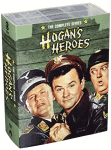|
 Most people have heard of the incredibly
accurate Norden
bombsight (see video of the Norden
bombsight) that was credited for revolutionizing accuracy of heavy bombers like
B-17s, B-24s, and B-29s. It was an electromechanical device that took bombardier
inputs of altitude, airspeed, heading, and wind speed and direction, then calculated
the impact point of the bomb. An accuracy of 75 feet was claimed under ideal conditions
- provided by a mechanical computing device. By 1956 when this article was published
(eleven years after WWII and three years after Korea), the Norden had been replaced
by radar-integrated bombing systems. Additionally, ground-based radar measurement
systems were in use to train aircrews without the need to drop physical bombs. Instead,
virtual bombs were launched and computers in a Radar Bomb Scoring (RBS) unit determined
where a real bomb would have hit. If you are a Hogan's Heroes fan (1970's TV series),
you might recall the episode entitled "Top Hat, White
Tie and Bomb Sights" which has Colonel Hogan sketching the "Norden" for the
Nazis. Most people have heard of the incredibly
accurate Norden
bombsight (see video of the Norden
bombsight) that was credited for revolutionizing accuracy of heavy bombers like
B-17s, B-24s, and B-29s. It was an electromechanical device that took bombardier
inputs of altitude, airspeed, heading, and wind speed and direction, then calculated
the impact point of the bomb. An accuracy of 75 feet was claimed under ideal conditions
- provided by a mechanical computing device. By 1956 when this article was published
(eleven years after WWII and three years after Korea), the Norden had been replaced
by radar-integrated bombing systems. Additionally, ground-based radar measurement
systems were in use to train aircrews without the need to drop physical bombs. Instead,
virtual bombs were launched and computers in a Radar Bomb Scoring (RBS) unit determined
where a real bomb would have hit. If you are a Hogan's Heroes fan (1970's TV series),
you might recall the episode entitled "Top Hat, White
Tie and Bomb Sights" which has Colonel Hogan sketching the "Norden" for the
Nazis.
Radar Scores SAC Bombing Test
|

At "Bombs away!" signal, radar pulse sent from plane is received
at Radar Bomb Scoring (RBS) station. Computers then graph hit or miss. Left, Col.
Harold A. Strack, RBS Group Commander, watches sky from atop van housing Mobile
Radar Control System (MSQ). Pulses received by antenna at his left are translated
into data and plotted by technicians shown below at work inside RBS control station.
|
Airmen cried "Bombs away!" but instead of devastating blasts the only visible
evidence of the crew's ability to destroy a target was cryptic electronic signals
observed by technicians at work inside a special radar station.
 This was the general picture during a recent
bombing and navigation competition between the huge bombing planes of the Strategic
Air Command (SAC). Some of the nation's top bombardiers and crews were rated with
unfailing accuracy, yet they never released one real bomb. It was all done by radar
and computers, linked together to form an ingenious tracking and scoring system
that has also been used as a valuable training aid for fledgling airmen. This was the general picture during a recent
bombing and navigation competition between the huge bombing planes of the Strategic
Air Command (SAC). Some of the nation's top bombardiers and crews were rated with
unfailing accuracy, yet they never released one real bomb. It was all done by radar
and computers, linked together to form an ingenious tracking and scoring system
that has also been used as a valuable training aid for fledgling airmen.
Here's what happens: when the airplane signals "Bombs away!" a radar pulse is
sent from the bomber to the ground station, known as a Radar Bomb Scoring (RBS)
unit. The station is built inside a mobile van. A Mobile Radar Control System (MSQ)
in the van uses the received pulses to track the course of the bomber, while computers
determine the accuracy of "hits." Blips across a radarscope represent the flight
path of the plane. The results of the scoring computer are shown as a thin red line
traced by an electronic "pen" on a sheet of blank paper. With this data, the RBS
group working in the van knows just where the "bomb" hits.
 Variable factors such as wind drift are
taken into account by the computers. Pinpoint accuracy enables the RBS personnel
to judge the amount of error in the bombardier's salvo. Similarly, the scores can
estimate the amount of damage that would ensue with a hit. Variable factors such as wind drift are
taken into account by the computers. Pinpoint accuracy enables the RBS personnel
to judge the amount of error in the bombardier's salvo. Similarly, the scores can
estimate the amount of damage that would ensue with a hit.
As a training aid, the RBS system provides crews with a sense of realism previously
missing from mock bombing runs. The MSQ radar and computing equipment was manufactured
for SAC by the Reeves Instrument Corp., a subsidiary of Dynamics Corp. of America,
25 West 43 St., New. York 36, N. Y.
Posted November 13, 2020
(updated from original post on 4/16/2015)
|












